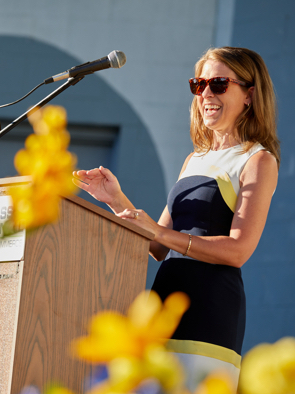Those of us in the higher education engineering space have likely heard Kellie Grasman’s name. As the co-author of Fundamentals of Engineering Economic Analysis, a contributor to corresponding online courses, and a member of the University of Michigan’s Center for Research on Teaching and Learning in Engineering, Kellie is a force of nature helping to shape and improve the learning experiences of future generations.
But how did Kellie discover higher education? After several years in the automotive industry, a relocation and a rapidly growing family led her to teaching. Since then, Kellie has spent nearly 20 years in the classroom teaching thousands of students, primarily in high-enrollment undergraduate engineering courses, and encouraging instructors to continue learning themselves.
“I was always trying out new pedagogies and technologies in the classroom,” Kellie says. “I love to think about how the design of the instructional content and learning environment can help create equitable opportunities for all students, and spend a lot of time exploring ways to implement education research in my teaching practice.”
We connected with Kellie to source her advice on empowering engineering students and how instructors switching modalities can excel.
zyBooks: How do you prepare your students for an engineering career?
Kellie Grasman: I always try to connect the content to topics that are relevant to students’ current lives and future careers. I emphasize the importance of economic analysis in design as great technology that still requires financial justification in the corporate world. That same analysis can help students make wise personal finance decisions today. It’s a great reward when students share how they’ve applied such analysis to make smart choices during the class and later in their professional engineering careers.
I strive to emphasize the importance of broad skills. It’s important for students to understand that engineers need strong communication skills, an ability to collaborate with diverse constituents, and an appreciation for the societal and ethical impacts of their engineering work.
How can schools and professors get more women and girls interested in engineering? How can we help them persist?
I feel strongly that the image of engineering that young people encounter at the earliest levels of schooling must be updated. Academia and industry must support K-12 education to help young students see the connection between engineering and society: Engineers solve problems for people. Higher education must create equitable learning environments to remove the barriers to success for underrepresented students in engineering. The world needs diversity in thought to solve our most pressing problems and engineers are well-suited to contribute.
What are your top three tips for instructors going “back to the classroom”?
I could speak to this for hours and have dedicated much of my work to this very question over the past academic year! Here’s the short version:
1. Interaction and engagement are key¹
- Set expectations for engagement on the first day of class.
- Introduce yourself on a personal level and ask your students to do the same.
- Connect early and continue to connect often.
- Create opportunities for students to engage with you and one another: in the classroom, during office hours, and through study groups or discussions.
2. Explore the enduring potential of technology
Technology has powerful potential to make teaching and learning more accessible for all. Consider the tools and practices that worked well during the emergency phase: What would continue to support student learning once we are back in the classroom? Virtual office hours, recorded lectures, digital assignment submissions, and alternative assessment practices all have enduring value as we move back to campus.²
3. Expect lingering impacts
We keep hearing the phrase “post-COVID,” but anyone who taught this past year knows it’s not “over.” Consider that we won’t likely return to the way it was. Expect and plan for continued disruption. Take care of yourself and your students. We all have a new appreciation of our shared humanity. Maybe we can use some of that to make some things better.³
Connect with instructors like Kellie
You can meet other like-minded STEM instructors by joining the zyCommunity, an online discussion space exclusively for zyBooks instructors.
¹From EDUCAUSE: “Students in the fall of 2020 reported meaningful experiences across all learning environments — online, hybrid, and face to face. But their most-positive experiences depended more on the number of opportunities for student-instructor interaction than on the type of learning environment itself. How instructors and students organized and spent class time, and the amount of feedback and direct interaction, mattered more…” Gierdowski, D., Brooks, C., Galanek, J. (2020). 2020 Student Technology Report: Supporting the Whole Student EDUCAUSE. Retrieved June 25, 2021 from https://www.educause.edu/ecar/research-publications/student-technology-report-supporting-the-whole-student/2020/introduction
²The Chronicle of Higher Education: “…online infrastructure for communicating and interacting with students is not going to disappear. Moving ahead needs to be on using technology to support faculty members and students, and make teaching and learning more accessible to all. The often-unspoken truth of education in the internet age is that — as textbooks, learning materials, and assessments, our foments become increasingly digitized — all learning will, in some capacity, be online learning.” Supiano, Becky (2021) A Pandemic Silver Lining: Widespread Reflection on Teaching. In McMurtie, B., and Supiano, B. The Future of Teaching: How the Classroom is Being Transformed (pp. 18-23). The Chronicle of Higher Education, May 2021.
³Beginning College Survey of Student Engagement (BCSSE)—35,000 students surveyed summer 2021: “…53 percent of first-year students reported a substantial increase in mental and emotional exhaustion. Of those, nearly 70 percent indicated “high expectations of academic difficulty,” compared to 42 percent of their peers who did not experience greater exhaustion. Additionally, 30 percent of students surveyed reported increased depression, 27 percent said they experienced greater loneliness and 20 percent felt more hopeless.” “The combination of mental and emotional exhaustion and expected academic difficulty strongly suggests an imperative to implement widespread and early check-ins by faculty, academic advisors, and student life staff to offer the support and—if necessary—intervention to help students’ first college year be successful.”
